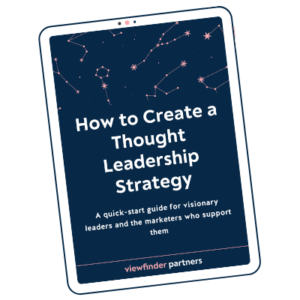ME ME ME ME ME ME.
Oh, sorry. Just warming up my vocal cords before I step up on my soapbox.
How often do we start by talking about ourselves? Especially when we’re communicating our big goals and most important ideas — the ideas we’re really proud of and excited about — we think ME ME ME.
It’s our nature to talk about ourselves. Especially when we’re in the weeds developing our product offering, or fine-tuning our branding, we’re thinking ME ME ME US US US.
But everyone else in the world? They…don’t really care. They’re busy inside their own heads, doing their own ME ME ME US US US.
So I’ve learned to try one little trick to make a message more interesting to other people: Spin it away from you. Make it 10% LESS about you and MORE about your audience.
Here’s how.
How to write more interesting thought leadership
Open with your audience’s perspective.
What are THEY thinking about, worried about, or dreaming about? Instead of opening your big announcement email with “We’re proud to announce,” think about why YOUR AUDIENCE cares about the announcement. Shift to: “You’ve told us you’re feeling the strain of the pandemic, and you need help doing XYZ. We built a new way to help you.”
Flip 10% of the sentences.
Scan your document. Look for “WE,” “OUR,” “I,” and your company name. Shift 10% of those sentences to be about “YOU,” “OUR CUSTOMERS,” or even asking a direct question to the reader. Shift from ME to YOU.
Describe their goals, not yours.
A lot of the marketing copy I see is pretty clearly in service of the company’s goals. I can smell the hunger for more revenue, more clients, more subscribers, less customer churn. It’s right under the surface. And I’ll speak just for myself here, but I am immediately turned off when I can tell that someone wants me to do something for them. I want to know: What’s in it for me? Why would it make my life better to download your research report, sign up for your emails, schedule a meeting, or hire you? Flip your language to center the other person’s goals — not yours.
Think of this trick as your hack to squeeze more empathy into every conversation — and to develop much more interesting thought leadership.



![what is a thought leader [paint palette image]](https://viewfinderpartners.com/wp-content/uploads/2019/11/im-not-a-thought-leader-1-300x200.jpg)



